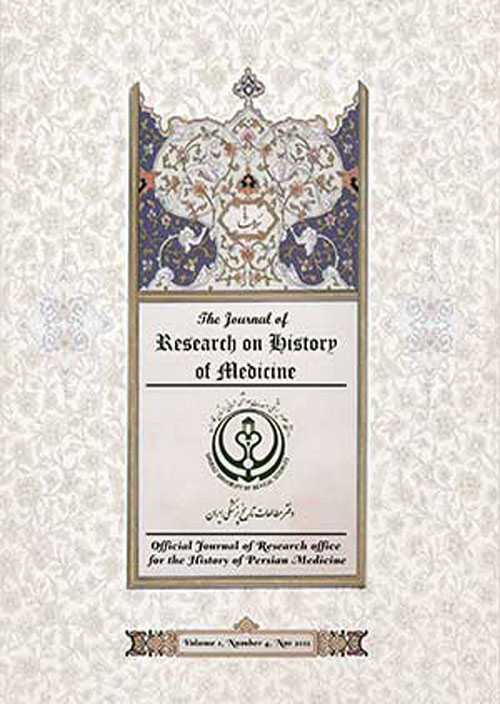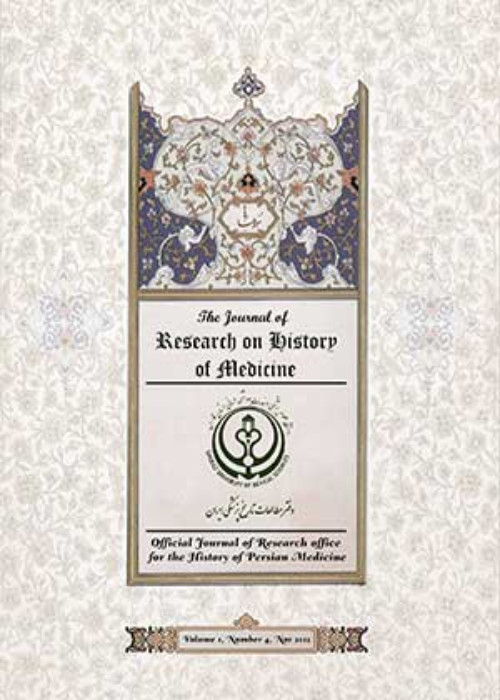فهرست مطالب

Journal of Research on History of Medicine
Volume:9 Issue: 4, Nov 2020
- تاریخ انتشار: 1399/09/26
- تعداد عناوین: 8
-
-
Pages 247-260
Persian Constitutional Revolution, in addition to changing the political and social structures of Iran, challenged the dominant discourse of traditional medicine. In the new approach to medical life, the government, physicians, and the educated class paid special attention to the issue of personal health and the need to diagnose diseases and their complications. Furthermore, they place special emphasis on disease prevention rather than treatment. To accomplish this, each took a particular mission. With the rise of journalism in post-constitutional Iran, they played a crucial role in advancing modern medical goals and educating people. In the present study, through the lens of a modern approach to journalism in medicine, taking an analytical approach, an attempt has been made to examine the mission of the Bidari newspaper to the issue of modern health and medicine in Kerman during the first Pahlavi period (1304-1320 SH/ 1925-1941 AD). Findings show that, to inform the public, the most important missions of the newspaper comprise putting emphasis on healthy living by identifying the types of common diseases in Kerman and the way to deal with them through paying attention to the principles of prevention and introducing governmental regulations in the field of medicine.
Keywords: Modern Medicine, Bidari newspaper, Kerman, Iran, Medicine, Traditional medicine -
Pages 261-268The transfer of medicine through the Northern roads of the Persian Gulf to the shores and backshores of the Persian Gulf has a long history. In the history of post-Islamic Iran, al-Buwayh was the first government who facilitated the transfer of medicine from the Northern and Southern ports of the Persian Gulf to Shiraz. The emirs of this dynasty, especially Adud al-Dawla, played an important role in transporting medicine from the Northern and Southern ports of the Persian Gulf to Shiraz by making the roads safe. The present study, by performing a library research and following a descriptive-analytic method, seeks to find out, firstly, what the most important routes of drug transfer from the Persian Gulf ports to Shiraz were, and secondly, what the rulers of Al-Buwayh did for the security of the roads from the Northern Persian Gulf to Shiraz. The research findings indicate that, in the Al-Buwayh era, imported medicines (such as Cinnamon, Barbahar, and Alpinia officinarum(khosrodaro) were used to be first unloaded in Sohar and Siraf ports and then be transferred to Shiraz through three important highways.Keywords: Al-Buwayh, Medicine, Persian Gulf, Cinnamon, barbahar, Alpinia officinarum (khosrodaro), Clove, Camphor
-
Pages 269-280The land of Andalusia was part of Dar al-Islam for about eight hundred years, and the prosperity of Islamic culture and civilization in this land made it one of the most brilliant scientific centers in the world, radiating knowledge all over Europe. Since the Muslim rulers of Andalusia strived to promote science and knowledge in this land, Andalusia turned to a territory in the period of Islamic civilization in which famous physicians, pharmacists and botanists were raised. Among them was Ibn Wafid Lakhmi, an Andalusian physician, pharmacologist and botanist who, while practicing medicine, also paid special attention to the subject of pharmacology and the cultivation of medicinal plants.Ibn Wafid treated patients with his own therapeutic and medicinal methods and with his numerous works and writings in the field of medicine, pharmacology and botany, he played an important role in expanding the scientific and civilizational boundaries of Islam in the field of these sciences. Ibn Wafid Andalusia, by training prominent students, was influential in the transmission of medical sciences, especially pharmacological and botanical knowledge, in the Islamic and world civilizations. The research method of this article is descriptive-analytical and the main question of the research is that what the role and function of Ibn Wafid Lakhmi as an Andalusian was in expanding the borders of medical sciences, pharmacology and botany in the Islamic civilization.Keywords: Ibn Wafid Lakhmi, Medicine, pharmacology, Botany, Andalusia
-
Pages 281-290Alzheimer’s disease is an irreversible progressive brain disorder which slowly affects memory and thinking skills and also the ability to carry out the simple tasks. Unani system of medicine has a history of clinical experience and rich traditional knowledge in the management of neuro-degenerative disorders. Unani Physicians, like Ali Ibn-e-Abbas Majusi (930-994 AD), in his book Kamilus sana; Abu Bakr Muhammad bin Zakariya Razi (850-925 AD), in Al Hawi; Sheikh-ur-Rais Ibn-e-Sina (980-1037), in his book Al-Qanoon fit tib; Ibn-e-Hobal Baghdadi (1122-1213), in Kitab-al-Mukhtarat fit tib; Abul Hasan Ahmed bin Muhammad Tabri (11th century), in Al Moalijat-e-Buqratiya; Azam Khan (19th century), in his book Rumooz-e-Azam have described conditions called Fasad-e-Zikr and Nisyan which are characterized by the loss of memory, resembling Alzheimer’s disease. They have not only mentioned its etiology and pathogenesis but also designed a specific line of treatment. These references can be traced up till Buqrat (Hippocrates) 377-460 B.C. and Jaalinoos (Galen) 130-200 AD.Keywords: Alzheimer Disease, Dementia, Unani Medicine, Memory Disorders, Fasad-e-Zikr, Nisyan
-
Pages 291-298
Cataract is mentioned as one of the most important blindness factors in the world. Management and treatment methods of cataract dates back to antiquity. Avicenna is one of prominent Persian scientists that played an important role in the development of ophthalmology in ancient Persia. In this review, Avicenna’s points of view about cataract is discussed in the Canon of medicine and compared with the current medicine. Cataract or “Nozol-al-maâ” is an obstructive disease due to the accumulation of a dense liquid layer between the lens and cornea. Avicenna categorized cataracts based on their density, size and color. To treat and manage cataract, he took three approaches: changing life style and nutrition in the first step; using simple and complex medicines in the next step; and performing surgery in the last stage. Nowadays, in vivo and in vitro studies have proven the effects of some food, nutraceuticals and medicinal plants in preventing cataractogenesis progression. As surgery is the only remedy of cataract today and postoperative problems may occur, finding new non-surgical procedures can be noteworthy.
Keywords: Persian medicine, eye diseases, Cataract, History of medicine -
Pages 299-308
Namazi Behbudistan is the oldest alive clinic in Shiraz. It was stablished as a clinic in 1925. Namazi is the name of the person who has donated this beautiful historical building to be used for medical purposes. The word Behbudistan contains two parts: “Behbud” which means healing and wellness and “istan” denoting to a place. The clinic was, first, managed by the municipally and has decades- long history of serving patients. Nowadays, this medical center belongs to Shiraz University of Medical Sciences. The research office for the history of Persian medicine is located in this beautiful historical building. In this paper, the history of foundation of this medical center is reviewed by examining some historical documents, such as the endowment letter related to this building.
Keywords: History of medicine, Shiraz, Medical center, Hospitals, Financial Management


